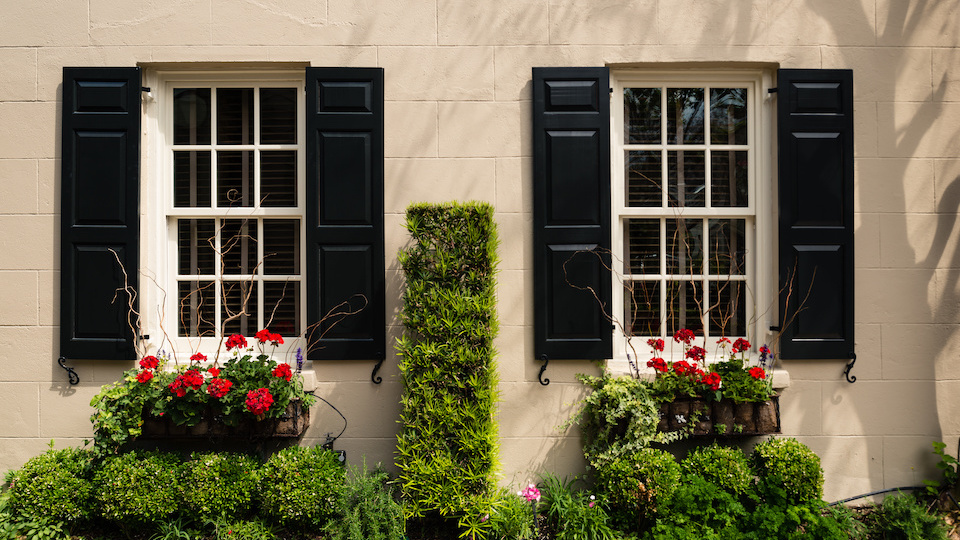Whether you live in the city, suburbia, or the country, window boxes add beauty, texture, color, charm, and even drama to your view. Adding window boxes brings flowers and foliage to eye level, which offers a different perspective than having them in your garden. From inside your home, plants create a lush view to the outdoors that can brighten your day no matter how gloomy the weather. And from the outside, plants and window boxes provide curb appeal that becomes part of the architecture. Here are three ideas for a beautiful view.
First things first…
If you’ve never had window boxes on your windows or balcony, you’ll need to install brackets to hold your window box in place. Take the measurements of your window before you buy or build your window box. Make sure your window box has plenty of holes for drainage and that it matches the style of your house and windows — go contemporary or classic.
Next, understand your light requirements. The amount of sunlight your window boxes receive is vital in figuring out which plants will grow best there. Then, choose a color theme and start with one plant. Don’t get overwhelmed with options. Instead, choose a plant for a focal point to anchor the box, add midsize plants around it, and cascading plants over the side of the box. But remember, these are just suggestions. First and foremost, choose flowers and plants that you love. Additionally, you want your window box to last as long as possible. So, choose a mixture of tightly packed plants that thrive in different temperatures.
Go edgy for a contemporary look
If you’re looking to make an edgy statement for your contemporary home, how about planting a succulent garden in your window box? Succulents work best in areas where there is plenty of sun. Thanks to their shallow root system, succulents grow great in small spaces. Here are some succulent varieties to choose from:
- Portulacaria afra
- Rosularia chrysantha
- Graptoveria ‘Opalina’
- Crassula perforata (baby necklace)
- Sedum rubrotinctum (jelly bean plant)
- Kalanchoe thyrsiflora (paddle plant)
- Aloe ‘Black Beauty’
- Echeveria ‘Tippy’
- Anacampseros telephiastrum variegata ‘Sunrise’
- Kalanchoe tomentosa (panda plant)
- Sedum morganianum (burro’s tail)
- Sedum pachyphyllum (stonecrop)
- Sedum nussbaumerianum (coppertone stonecrop)
Tips: Choose a potting soil that drains well, like a ready-made cactus mix. Add two parts cactus mix and one-part pumice, so that the potting mix doesn’t stay too wet. Add polished pebbles and stones around the plants for interest. Never over-water your succulents — that’s a surefire way to kill them. When the first inch of soil has dried, wait about a week and then water your box. Succulents thrive on sunlight. But the less sun, the less water they will need. When you do water, thoroughly drench the soil. Feed your succulents a quality, organic liquid fertilizer (10-10-10) diluted, every month during the spring, summer, and fall.
Go rich to liven up neutral-colored boxes and backdrops
Foliage like coleus (which comes in both sun and shade varieties) makes a stunning, rich, focal point, filler, and accent plant when surrounded by a gentler plant like asparagus fern. Rich colors are perfect for neutral-colored window boxes and backdrops such as beige, ivory, taupe, black, gray, and shades of white. Although, varieties like “Kong Red” and “Chocolate Covered Cherry” are bold enough to take center stage in a window box. Impatiens, begonias and other warm-season annuals combine very well with coleus. Additionally, Wandering Jews (also known as spiderworts) make perfect, trailing vines for flower boxes. They’re prized for the white, green, silver, and purple stripe colors of their foliage.
Tips: Choose a fertile, well-drained soil and a container that holds moisture well. These rich plants and flowers prefer partial shade. To feed, mix a light application of a balanced organic fertilizer into the soil before planting. During midsummer, plants should be drenched with liquid plant food to stimulate new growth.
Go vibrant all summer long
Nothing shouts summer like a window box full of vibrant petunias that continuously bloom even in summer’s harshest heat. Fill your flower box with these annuals in shades of purple, red, pink, white, striped, and speckled. For bushier varieties, choose “Petunia axillaris” or “wild white petunia.” Add additional cascading varieties that spill over the sides, such as “Wave” or “Surfinia petunias.”
Tips: Plant petunias in light, well-drained soil in full sun. They can grow in partial shade, but they will have fewer flowers. When planting petunias in flower boxes, The Old Farmer’s Almanac suggests using a soilless mix. Water thoroughly once a week, and feed your plants monthly to ensure good growth. Remove all faded and dead flowers to extend blooming.
Allow window boxes to become part of the architecture
Create a seamless look for your windows by painting your window boxes the same color as the window frame — such as a light gray, onyx, or creamy white. By doing so, your window boxes become part of the architecture, and the plants themselves make a bold statement for your home. Go big and bold and fill them with lavish spikes of snapdragons that grow 12 to 18 inches tall. Or, add height with ornamental grass. Fuchsia magellanica is typically used in hanging baskets, but these colorful flowers are a fun and vibrant addition to any window box. Remember…when it comes to window boxes; you’re limited only by your imagination — so go for it!
-Katherine Marko




